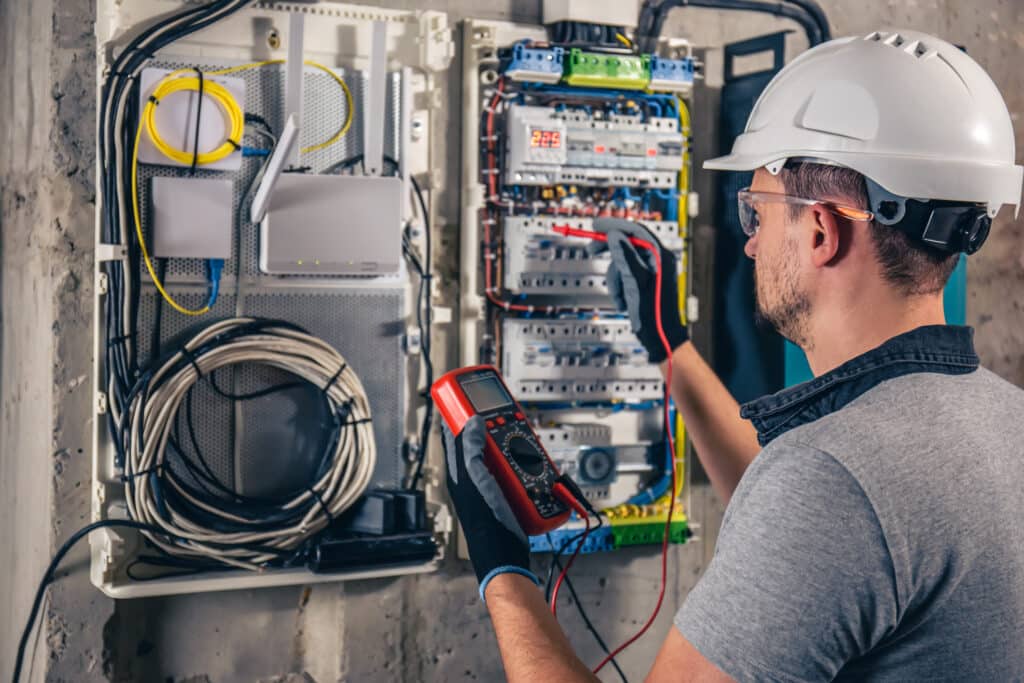
Understanding the Importance of Circuit Testing
Circuit Testing is key to making sure electronics work right. It checks that parts like printed circuit boards (PCBs) are made correctly by looking for shorts and openings and measuring basic stuff. One way to do this is through in-circuit testing (ICT), which uses probes and special tools like the bed-of-nails tester to do thorough checks. This helps make production quicker and easier to troubleshoot.
Understanding Circuit Testing
Ensuring electronics are dependable involves rigorous evaluation.
Ever ponder how each tiny component on a circuit board is verified for functionality?
This crucial process is known as circuit testing.
It checks boards for shorts, opens, resistance, and capacitance to guarantee smooth operation.
A common approach is in-circuit examination, a prevalent type of white box testing in the industry, utilizing probes to verify board standards.
An intriguing instrument in this domain is the bed-of-nails tester, which employs spring-loaded pins, known as “pogo pins,” to contact specific points on the board, aiding in assessing the board’s condition.
While in-circuit systems typically target particular components, sophisticated tools like cameras and signal analyzers can evaluate various aspects, from LED brightness to high-frequency crystals.
In Wilmington, NC, services offered by Mister Sparky highlight the value of professional expertise in electrical safety and upkeep.
Leveraging local proficiency ensures secure and dependable electrical infrastructures, minimizing failure risks.
Effective circuit evaluation enhances safety, elevates product quality, and fosters customer confidence.
Importance of Professional Circuit Testing
There are several methods for circuit testing, each with its own uses and perks.
In-circuit testing (ICT) is a method that uses an electric probe to check a printed circuit board (PCB) for problems like shorts, opens, or incorrect part values.
ICT uses a tool called a bed-of-nails tester, which has spring pins, or “pogo pins,” that touch test points on the PCB to ensure everything is in order.
This technique is great for making lots of boards because it’s precise and quick.
Another key method is Functional Testing, which checks if the whole board works as it should.
This test simulates its use to make sure all the parts work correctly.
Functional testing is crucial for finding problems that ICT might miss, such as software glitches or system mix-ups.
There are also Boundary Scan Testing and Automated Optical Inspection (AOI).
Boundary Scan tests connections on PCBs that are hard to reach by using Joint Test Action Group (JTAG) standards.
AOI uses a camera to examine PCBs for surface flaws, making it easier to spot soldering errors and missing parts.
Each of these methods has its own benefits, offering a layered way to conduct circuit testing that boosts reliability and performance assurance.
For complex circuit evaluation and to ensure safety and functionality, contacting professionals like Mister Sparky of Wilmington, NC, is advised.
Circuit Testing: Breaking It Down
When you think of circuit evaluation, there’s a lot going on behind the scenes.
Its main goal is to test how strong a printed circuit board (PCB) is.
The “bed-of-nails” tester, using “pogo pins,” plays a key role.
It’s not just a catchy name; it checks each circuit by probing it at certain points to spot issues like shorts and openings.
The hardware comes with various parts like electric probes and advanced tools such as cameras and sensors.
These extras are key for measuring things beyond the usual, like LED color and changes in high-frequency crystals.
This setup makes it easier to spot small problems, which helps with fixing issues faster.
On the software side, this testing utilizes smart systems to process loads of data, focusing only on real errors and giving useful tips.
The teamwork between hardware and software boosts quality, helping various industries, including those in Wilmington, NC, maintain top-notch reliability.
Getting to know this process shows how important it is to test circuits to make sure devices work well.
Why Fixtures Matter in Circuit Testing
Fixtures are key in Circuit evaluation.
They connect the test gear to the circuit board.
The bed-of-nails tester is often used because it’s efficient.
It has many pogo pins that make sure every test point on the board is touched.
This is crucial, as even a small slip can throw off readings.
Beyond ensuring good contact, fixtures streamline setup, guaranteeing uniformity in each test and reducing external interference.
There are two main types of fixtures: dedicated and universal.
Dedicated fixtures are made for specific boards, offering great accuracy but not much flexibility.
Universal fixtures can be used with different boards but might not be as precise.
By holding the circuit board in place, fixtures ensure tests are stable and accurate.
With additional tools like cameras or waveform analyzers, these fixtures can perform tasks such as checking LED color or high-frequency oscillators, maintaining quality standards essential for Circuit Testing in Wilmington, NC.
The Importance of Professional Circuit Testing
Circuit evaluation involves a few key steps that need care and focus, and often it’s best left to professionals.
First, the preparation and setup phase is crucial.
This includes selecting the right tools, like testers and multimeters, for accurate measurements.
Reviewing the circuit board’s plans and specifications beforehand helps ensure a smooth and accurate test.
When professionals begin circuit evaluation, they connect test probes to specific spots on the circuit to assess functionality.
Many experts use a bed-of-nails tester with spring-loaded pins to precisely touch designated points on the board.
At this stage, they measure resistance, capacitance, and continuity, allowing them to identify and address issues like shorts or breaks immediately.
In complex cases, professionals might use advanced tools or cameras to monitor more intricate aspects, such as the color of LEDs or the frequency of oscillators.
Each step is vital, ensuring the circuit operates efficiently while reducing mistakes and enhancing reliability.
For safe and effective results, consider hiring Mister Sparky of Wilmington, NC, for your electrical testing needs.
Understanding Circuit Testing Tools

In the world of electrical work, having the right tools is essential.
Continuity testers are simple yet effective devices used to check if there’s an unbroken path in your circuit, which helps in quickly locating any breaks.
Multimeters serve as indispensable tools, measuring voltage, current, and resistance to ensure everything is functioning correctly, much like a Swiss Army knife for electrical diagnostics.
Another helpful tool for circuit evaluation is the circuit tester.
It’s useful for identifying issues in power outlets, switches, and various fixtures promptly.
For more complex systems, tools like oscilloscopes and logic analyzers provide detailed insights, analyzing waves and signals to uncover a circuit’s structure.
These tools are crucial for helping professionals understand electrical systems thoroughly, ensuring each component operates correctly.
Utilizing the right tools not only enhances the accuracy of work but also ensures safety.
For complex tasks or if you’re unsure, it’s always best to contact Mister Sparky of Wilmington, NC to handle your electrical assessment needs professionally.
Advantages of Circuit Testing
Circuit evaluation offers numerous benefits that make it essential in the creation and repair of electronics.
First, it’s about being efficient.
Spotting problems early cuts down on long troubleshooting times that can halt production.
This early action speeds up the whole assembly process and makes the product work better.
Then there’s reliability, which really stands out.
With thorough testing, makers ensure parts meet specs, cutting down failures in the field.
This boosts customer happiness and trust—important in today’s market.
Troubleshooting is also a big plus.
Techniques such as in-circuit testing (ICT) are used to find and fix faults in a printed circuit board (PCB).
This method finds problem parts without taking apart the whole circuit, saving time and money.
In the long run, you also get lower maintenance costs and longer product life, which makes testing a wise investment.
By using these tests, businesses stick to high-quality standards and build a reputation for being reliable and top-notch in Wilmington, NC, and beyond.
Constraints of Circuit Testing
Circuit evaluation is key to making sure a product works well, but it has its issues.
One big limit is what standard in-circuit evaluation (ICT) gear can do.
It’s usually set to test only certain parts at preset spots.
ICT is great for checking assembly by finding shorts, opens, and resistance flaws, but it mainly uses a “bed-of-nails” tester.
This tester needs easy access to test points on a printed circuit board (PCB).
This need can limit how flexible and adaptable testing is, especially with complex circuits that need detailed probing.
Testing parts like crystals and oscillators that run at very high frequencies might need extra tools, like signal waveform analyzers, which complicates things.
To enhance circuit evaluation coverage and boost accuracy, especially for checking LED light intensity, specialized tools managed by professionals can be utilized.
Still, there are ways to beat these limits.
Using modular test setups that can grow and flexible software that adjusts to different test needs helps.
By knowing and tackling these limits, pros in places like Wilmington, NC can make testing better, making sure devices meet high standards before they hit the market.
Advances in Circuit Testing Technology
Circuit evaluation is getting a boost from new tech to make it more accurate and fast.
One big change is using AI.
AI can quickly look at a lot of circuit data, spot trends, and find possible issues before they happen.
This makes troubleshooting better and boosts reliability in fields like aerospace and healthcare.
Another key update is using the Internet of Things (IoT) in tests.
IoT devices give real-time data and let you monitor remotely.
This means you get quick feedback and can make fast changes, cutting downtime and boosting output.
Plus, automated testing equipment (ATE) has transformed how circuits are checked.
ATE systems cut down errors by running tests fast and consistently.
They handle complex tests that are tough to do by hand, giving in-depth checks and clear insights.
These new tech advances make circuit evaluation more effective and fit with the industry trend toward more automation and digitization.
Mister Sparky of Wilmington, NC, ensures they remain at the forefront of electrical solutions by incorporating these innovations, providing top-notch reliability and performance to their clients in the area.
Ensuring Quality Through Effective Testing
To deliver dependable technology, it’s crucial to follow the best steps in circuit evaluation.
Careful procedures make sure testing is both quick and correct.
This means using tools like multimeters and testers to find shorts, opens, and other issues that could mess up production.
Smoothing out test steps can boost output, allowing for faster delivery without losing quality.
Circuit evaluation methods are only as good as the people using them.
It’s important for technicians to be well-trained and follow industry rules.
Using the latest software and hardware tools in the testing process ensures exactness and helps avoid costly recalls and failures.
For instance, adding photodetectors and cameras to testers can improve inspections by checking important details like LED color.
Being proactive is key—finding defects early reduces risks and ensures devices work well.
By keeping test rules updated and using new tech, firms can keep high standards and protect their good name.
Whether in Wilmington, NC, or anywhere else, good circuit testing is vital for tech success and happy customers.
Staying Safe During Circuit Testing
Circuit evaluation can be easy if you put safety first.
Always make sure the equipment is off before you start.
This simple action can stop electric shocks or worse.
Use good safety gear like insulated gloves and goggles to guard against sudden sparks or splashes.
Keep your workspace clean when working with testers.
Loose wires can cause unexpected issues or harm.
Check connections twice before you turn on the power to avoid costly mistakes or injuries.
Wearing the right gloves and safety gear is a must.
Rubber-soled shoes help prevent grounding issues, and your gloves and clothes should offer the right level of protection.
Also, watch out for the risks with complex devices like delicate sensors or high-frequency parts.
If you handle these wrong, it could lead to big damage or injuries.
Consulting with a professional in Wilmington, NC, for tasks involving these devices is advised to ensure safety.
Putting these safety tips first not only keeps people secure but also makes testing more dependable.
Remember, it’s not just about testing; it’s about keeping everyone safe and at ease when working with circuits.
Circuit Testing Standards
Circuit testing ensures electronic devices operate safely and efficiently.
Following standard guidelines is vital for maintaining product quality and avoiding costly errors.
Key standards to be familiar with include IEC, ANSI, and ISO.
These organizations establish fundamental rules for testing and safety, ensuring components meet global norms.
Adhering to these standards is crucial for obtaining certifications, which are often necessary for consumer trust and market entry.
Standardization maintains consistency in testing methods and results, which is crucial in industries where dependability is key.
Standards often dictate the tools and software used, ensuring precise operations.
For instance, they may prescribe how to use in-circuit evaluation (ICT) with devices like bed-of-nails testers to detect shorts, opens, and other issues.
Certification bodies provide a mark of reliability, indicating that a product meets specific engineering and safety standards.
For businesses in Wilmington, NC, adhering to these standards not only builds consumer confidence but also simplifies compliance with local regulations.
Focusing on these guidelines is essential for high-quality and dependable circuit evaluations.
Choosing Circuit Testing Services in Wilmington
Choosing the right service for your electronic devices can really affect how well they perform.
You should focus on providers who know their stuff in-circuit testing and use the latest tech.
Find ones who have the skills you need, like in-circuit evaluation with tools like the bed-of-nails tester, which uses lots of “pogo pins” to check your circuit boards thoroughly.
Local know-how is a plus in this area.
Providers who are familiar with local rules and the environment can give you solutions that fit better.
Being nearby also means they can respond faster and give you more personal help.
Services from trusted names like Mister Sparky of Wilmington, offer a full package to fit your needs, making sure your testing is both efficient and precise.
When choosing a circuit evaluation service, go for providers with good reviews and a solid track record.
Make sure they can perform both simple tests and more detailed ones.
This careful approach is key for the best performance and long life of your electronics, saving you from future hassles.
FAQs
What is circuit testing, and why does it matter?
Circuit testing checks if electronic circuits work right. It’s key for spotting and fixing problems early in making them, which boosts reliability and cuts future issues.
How is in-circuit testing (ICT) different from other methods?
In-circuit evaluation checks single parts on a circuit board with electrical probes to spot shorts and opens. This is different from functional testing, which looks at how the whole system works together.
What tools are common for circuit testing?
Circuit testing often uses tools like continuity testers, multimeters, and special circuit testers. These tools let techs measure electrical flow, resistance, and signal strength easily.
Why pick Mister Sparky of Wilmington, NC, for electrical work?
Mister Sparky in Wilmington offers trustworthy and professional electrical work. They are known for their quality, on-time service, and clear communication, making sure they meet your needs well.
What should I look at when choosing a service for testing circuits in Wilmington, NC?
Look at the provider’s know-how, reputation, and services. Also, consider how close they are, online reviews, and if they follow industry standards to make a smart choice.


